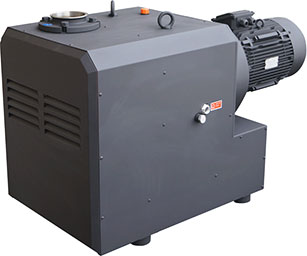Rotary Claw Vacuum Pumps (HS series)
Selectorr HS Series oil-less rotary claw vacuum pumps are ideal for a multitude of applications, especially those where quiet operation is needed. Direct driven by 1750 RPM Nema motors, these pumps feature low operating temperatures and reduced power consumption.
All models can be operated continuously with minimal maintenance required. The HS models are well suited for surgicenters, medical/lab vacuum, pneumatic conveying, and packaging.
Spec Sheet

| MODEL | C3C-HS | C5C-HS | C7C-HS | C10C-HS | C15LC-HS |
| Part # (with motor) | 264410 | 264411 | 264412 | 264413 | 264414 |
| Part # (without motor) | 264363-LM | 264364-LM | 264365-LM | 264366-LM | 264367-LM |
| Motor HP 60 Hz | 2 | 3 | 5 | 7.5 | 7.5 |
| RPM 60/50 Hz | 1750/1450 | 1750/1450 | 1750/1450 | 1750/1450 | 1750/1450 |
| Inlet/Discharge Connections | 1 1/2" | 1 1/2" | 2"/1 1/2" | 2"/1 1/2" | 3"/2 1/2" |
| dB(A), average 60 Hz | 67 | 68 | 68 | 70 | 71 |
| Approximate Weight Pump Only (lb.) | 280 | 302 | 514 | 548 | 741 |
| Approximate Weight with Motor (lb.) | 370 | 445 | 747 | 787 | 1063 |
| Gear Box Oil Capacity (quarts) | 0.5 | 0.5 | 1.0 | 1.0 | 2.0 |
| Dimensions | drawing | drawing | drawing | drawing | drawing |
| ACFM @ 0" | 35 | 56 | 99 | 110 | 142 |
| ACFM @ 10" | 34 | 56 | 96 | 107 | 137 |
| ACFM @ 15" | 33 | 54 | 93 | 105 | 133 |
| ACFM @ 19" | 32 | 53 | 89 | 103 | 130 |
| ACFM @ 22" | 31 | 52 | 87 | 99 | 126 |
| ACFM @ 25" | 30 | 50 | 85 | 95 | N.A. |
| Ultimate Vacuum, Max, " Hg. | 26" | 25" | 24" | 24" | 24" |
| Ultimate Vacuum, Continuous, " Hg. | 25" | 24" | 23" | 23" | 23" |
| SCFM @19" Hg. | 11.7 | 19.4 | 32.5 | 37.5 | 47.6 |
Rotary claw vacuum pumps can operate continuously and dependably for long periods of time. Inlet filters are typically used for both vacuum and compressor applications in order to trap contaminants from entering the pumping chamber.
A claw vacuum pump consists of two rotors. The rotors turn in opposite directions, without contact, with very tight clearances. They are synchronized via a precision gear. As the claw moves over the suction connection and the axial suction channel inlet, gas is sucked into the compression chamber.
The revolving rotors move gas from the suction side to the pressure side. Then it is compressed by the reduction of the volume between the rotors until the lower rotor uncovers the discharge channel. This "internal compression" leads to high differential pressures at efficiencies of more than 60%. To remove the heat generated by the compression process, cooling air is sucked in between the compression housing and a silencing cover before leaving the pump.
